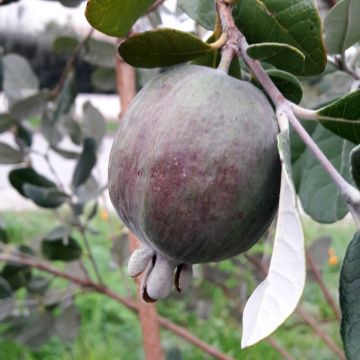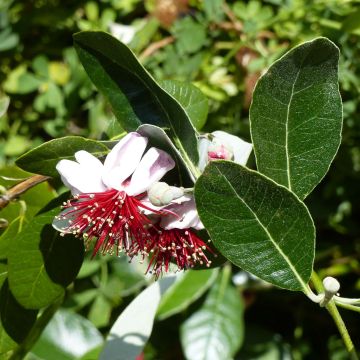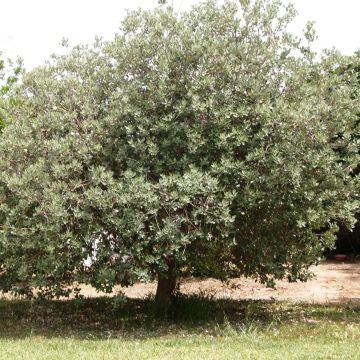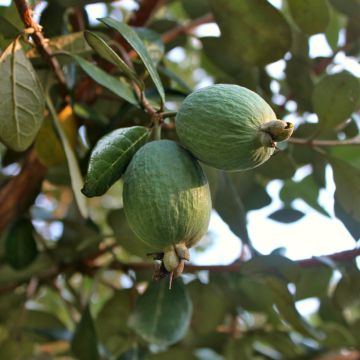

Feijoa Sellowiana
Feijoa sellowiana
Feijoa sellowiana
Pineapple Guava, Guavasteen
What type of soil does it need for proper growth? Thank you. Response from Promesse de Fleurs: This young plant requires a light and well-drained ordinary soil and thrives in sunlight and warmth.
Alain, 01/11/2016
Special offer!
Receive a €20 voucher for any order over €90 (excluding delivery costs, credit notes, and plastic-free options)!
1- Add your favorite plants to your cart.
2- Once you have reached €90, confirm your order (you can even choose the delivery date!).
3- As soon as your order is shipped, you will receive an email containing your voucher code, valid for 3 months (90 days).
Your voucher is unique and can only be used once, for any order with a minimum value of €20, excluding delivery costs.
Can be combined with other current offers, non-divisible and non-refundable.
Why not try an alternative variety in stock?
View all →This plant carries a 6 months recovery warranty
More information
We guarantee the quality of our plants for a full growing cycle, and will replace at our expense any plant that fails to recover under normal climatic and planting conditions.

Would this plant suit my garden?
Set up your Plantfit profile →
Description
The Feijoa sellowiana, also known as Acca sellowiana or Brazilian Guava, is an evergreen bush with an exotic charm, and exceptional summer flowering. Its fleshy, edible flowers are made of pink-white or purple petals, open in a corolla around a burst of large purple stamens. They are followed, with a long and hot summer, by delicious fruits that remain green, whose taste is reminiscent of pineapple. Its foliage is almond green, tough, covered with a silvery down at birth. This small tree has a rare and elegant personality, attracting all eyes to its attractive silhouette all year round. It prefers mild climates, but is surprisingly hardy. It appreciates the sun and heat to bloom and bear fruit well, and is content with ordinary well-drained soil, even temporarily dry. It will settle in large pots on the terrace, in isolation, in an orchard, in a hedge or in beds, in a sheltered location.
The Acca sellowiana, also known as Montevideo Guava, is a partially self-fertile small tree from the Myrtle family, native to South America: Colombia, Uruguay, Brazil and Paraguay. In nature, this bushy shrub reaches 6 m (19 ft 8 in) in height, but it will settle for 2 to 3 m (6 ft 7 in to 9 ft 10 in) in our climates, for a spread of 1.50m (4 ft 11 in). Its growth is quite slow in the first few years. It can very well be grown for purely ornamental purposes. It is interesting for several reasons:
First for its summer flowering, in June-July-August depending on the climate, both spectacular and delicious. Its fleshy flowers stand out well from the foliage. They are solitary, purple, white, red and fleshy. The petals have a fruity, sweet and sour flavour. They are edible and can bring an exotic note to salads.
When summer is long and hot, the flowers manage to give fruits which ripen late in October. They are called feijoas, pineapple guavas, Brazilian guavas or Montevideo guavas, resemble hairless green kiwis, and are covered with a rough green skin that remains even when ripe. The pulp is granular, it contains seeds, and has a slightly acidic taste, whose aroma recalls both pineapple, guava and strawberry. The flesh is rich in vitamins B and C.
Then for its elegant habit and its evergreen foliage, composed of ovate and tough leaves, a beautiful almond green, while they are born covered with a silver white down. The bark covering the trunk is reddish, covered with patches of light bark.
Feijoa sellowina is a bush that offers several delightful surprises with its naturally bushy structure and beautiful flowers. It can be used to create hedges but also makes an impressive standalone specimen when planted on a terrace or in a garden. To ensure good fruiting, cross-pollination is necessary, which can be achieved by planting several trees together. Growing fresh seeds is a cost-effective way to obtain multiple trees. This Brazilian guava is a hardy plant that can withstand temperatures as low as -15°C (5 °F), is resistant to pests and drought, and can easily grow in the kiwi zone. It is an excellent addition to any garden, and its pineapple-guava fruit is truly a delight.
Report an error about the product description
Flowering
Foliage
Plant habit
Botanical data
Feijoa
sellowiana
Myrtaceae
Pineapple Guava, Guavasteen
South America
Other Feijoa trees - Acca
View all →Planting and care
Feijoa sellowiana seeds are viable for only one year. It's best to plant them right after harvest, yielding a harvest in 3 to 5 years. Soak the seeds in warm water for 1 to 2 hours before planting at any time of the year.
Plant the seeds in trays or pots filled with special sowing soil. Keep them warm between 13 and 15°C (37.4 to 59°F) and bury them 1.5mm (0.1 in) deep. Keep the sowing in the light to help them germinate.
When the young plants are large enough, transplant them to larger pots, starting with 8 cm (3.1 in), then 13 cm (5.1 in), and finally 20 cm (7.9 in) diameter pots.
No pruning is necessary if you want to use a feijoa bush as a hedge. If you prefer to form an individual on a stem, slight shaping pruning is recommended at the end of winter. Keep in mind that fruits develop on the spring branches.
Feijoa needs plenty of sun and heat, so it's best to plant it in a sheltered area with plenty of sun, such as a southern wall. If harsh winter freezes its branches, it will start again from the stump. It tolerates some passing droughts and accepts ordinary, slightly calcareous, neutral to slightly acidic soils, as long as they are well-drained.
Usually, feijoas are not picked; the fallen fruits are collected. When opening the fruit, it is good to consume if the central area containing the seeds is gelatinous and translucent in appearance. Before ripeness, this area is opaque; after, it takes a brown colour. The fruits have a relatively short shelf life.
Sowing period
Intended location
-
, onOrder confirmed
Reply from on Promesse de fleurs
Haven't found what you were looking for?
Hardiness is the lowest winter temperature a plant can endure without suffering serious damage or even dying. However, hardiness is affected by location (a sheltered area, such as a patio), protection (winter cover) and soil type (hardiness is improved by well-drained soil).

Photo Sharing Terms & Conditions
In order to encourage gardeners to interact and share their experiences, Promesse de fleurs offers various media enabling content to be uploaded onto its Site - in particular via the ‘Photo sharing’ module.
The User agrees to refrain from:
- Posting any content that is illegal, prejudicial, insulting, racist, inciteful to hatred, revisionist, contrary to public decency, that infringes on privacy or on the privacy rights of third parties, in particular the publicity rights of persons and goods, intellectual property rights, or the right to privacy.
- Submitting content on behalf of a third party;
- Impersonate the identity of a third party and/or publish any personal information about a third party;
In general, the User undertakes to refrain from any unethical behaviour.
All Content (in particular text, comments, files, images, photos, videos, creative works, etc.), which may be subject to property or intellectual property rights, image or other private rights, shall remain the property of the User, subject to the limited rights granted by the terms of the licence granted by Promesse de fleurs as stated below. Users are at liberty to publish or not to publish such Content on the Site, notably via the ‘Photo Sharing’ facility, and accept that this Content shall be made public and freely accessible, notably on the Internet.
Users further acknowledge, undertake to have ,and guarantee that they hold all necessary rights and permissions to publish such material on the Site, in particular with regard to the legislation in force pertaining to any privacy, property, intellectual property, image, or contractual rights, or rights of any other nature. By publishing such Content on the Site, Users acknowledge accepting full liability as publishers of the Content within the meaning of the law, and grant Promesse de fleurs, free of charge, an inclusive, worldwide licence for the said Content for the entire duration of its publication, including all reproduction, representation, up/downloading, displaying, performing, transmission, and storage rights.
Users also grant permission for their name to be linked to the Content and accept that this link may not always be made available.
By engaging in posting material, Users consent to their Content becoming automatically accessible on the Internet, in particular on other sites and/or blogs and/or web pages of the Promesse de fleurs site, including in particular social pages and the Promesse de fleurs catalogue.
Users may secure the removal of entrusted content free of charge by issuing a simple request via our contact form.
The flowering period indicated on our website applies to countries and regions located in USDA zone 8 (France, the United Kingdom, Ireland, the Netherlands, etc.)
It will vary according to where you live:
- In zones 9 to 10 (Italy, Spain, Greece, etc.), flowering will occur about 2 to 4 weeks earlier.
- In zones 6 to 7 (Germany, Poland, Slovenia, and lower mountainous regions), flowering will be delayed by 2 to 3 weeks.
- In zone 5 (Central Europe, Scandinavia), blooming will be delayed by 3 to 5 weeks.
In temperate climates, pruning of spring-flowering shrubs (forsythia, spireas, etc.) should be done just after flowering.
Pruning of summer-flowering shrubs (Indian Lilac, Perovskia, etc.) can be done in winter or spring.
In cold regions as well as with frost-sensitive plants, avoid pruning too early when severe frosts may still occur.
The planting period indicated on our website applies to countries and regions located in USDA zone 8 (France, United Kingdom, Ireland, Netherlands).
It will vary according to where you live:
- In Mediterranean zones (Marseille, Madrid, Milan, etc.), autumn and winter are the best planting periods.
- In continental zones (Strasbourg, Munich, Vienna, etc.), delay planting by 2 to 3 weeks in spring and bring it forward by 2 to 4 weeks in autumn.
- In mountainous regions (the Alps, Pyrenees, Carpathians, etc.), it is best to plant in late spring (May-June) or late summer (August-September).
The harvesting period indicated on our website applies to countries and regions in USDA zone 8 (France, England, Ireland, the Netherlands).
In colder areas (Scandinavia, Poland, Austria...) fruit and vegetable harvests are likely to be delayed by 3-4 weeks.
In warmer areas (Italy, Spain, Greece, etc.), harvesting will probably take place earlier, depending on weather conditions.
The sowing periods indicated on our website apply to countries and regions within USDA Zone 8 (France, UK, Ireland, Netherlands).
In colder areas (Scandinavia, Poland, Austria...), delay any outdoor sowing by 3-4 weeks, or sow under glass.
In warmer climes (Italy, Spain, Greece, etc.), bring outdoor sowing forward by a few weeks.





































